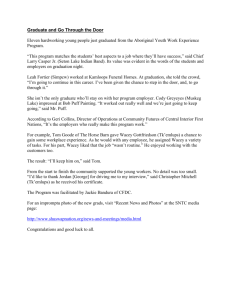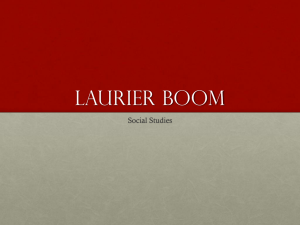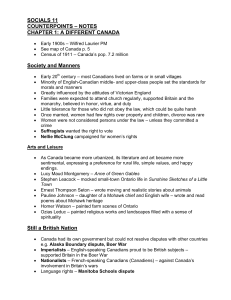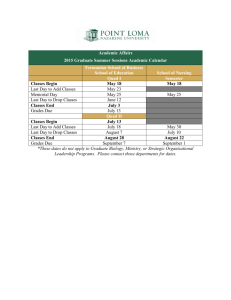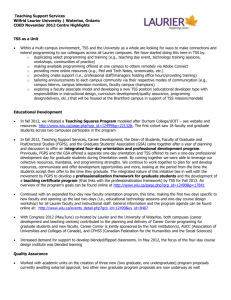Strategic Mandate Agreement - Ministry of Training, Colleges and
advertisement
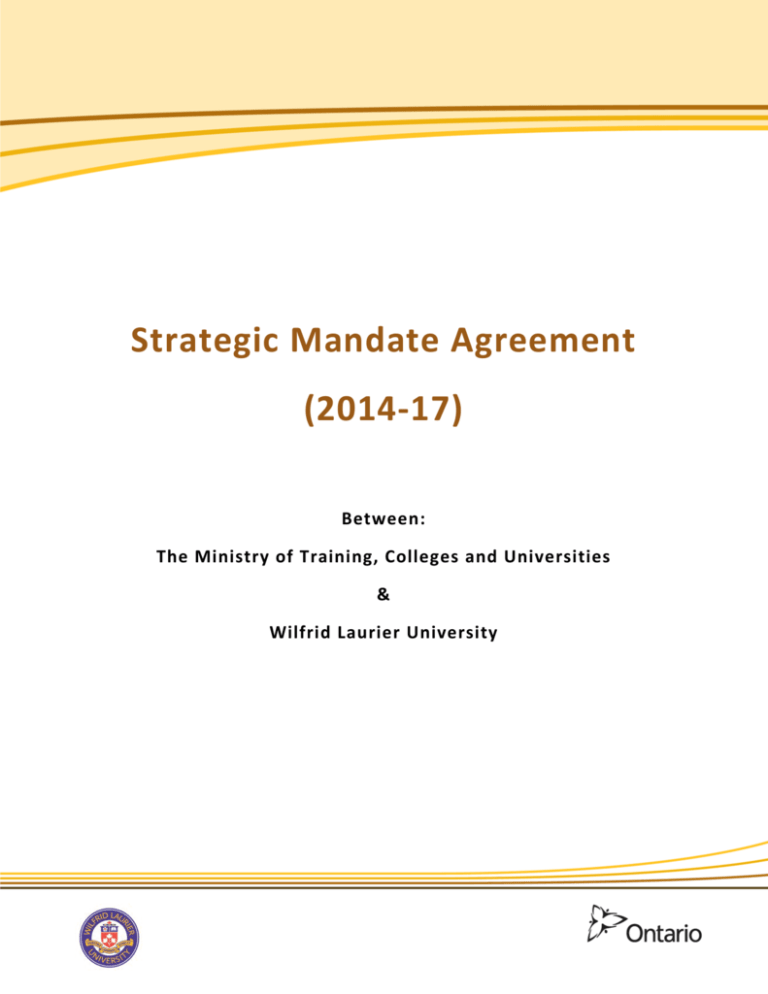
Strategic Mandate Agreement (2014-17) Between: The Ministry of Training, Colleges and Universities & Wilfrid Laurier University ONTARIO’S VISION FOR POSTSECONDARY EDUCATION Ontario’s colleges and universities will drive creativity, innovation, knowledge, and community engagement through teaching and research. They will put students first by providing the best possible learning experience for all qualified learners in an affordable and financially sustainable way, ensuring high quality and globally competitive outcomes for students and Ontario’s creative economy. WILFRID LAURIER UNIVERSITY VISION/MANDATE Wilfrid Laurier University will: (1) lead the province and the nation in combining the comprehensive human development of students with outstanding intellectual development in a liberal arts and sciences tradition, and (2) lead by example in innovative and highly efficient multi-community, multi-campus delivery of academic and professional undergraduate and graduate programs within a comprehensive university context. PREAMBLE This Strategic Mandate Agreement between the Ministry of Training, Colleges and Universities (the Ministry) and Wilfrid Laurier University outlines the role the University currently performs in the postsecondary education system and how it will build on its current strengths to achieve its vision and help drive system-wide objectives articulated by the Ministry’s Differentiation Policy Framework. The Strategic Mandate Agreement (SMA): • • • Identifies the University’s existing institutional strengths; Supports the current vision, mission, and mandate of the University within the context of the University’s governing legislation and outlines how the University’s priorities align with Ontario’s vision and Differentiation Policy Framework; and Informs Ministry decision making through greater alignment of Ministry policies and processes to further support and guide the University’s areas of strength. The term of the SMA is from April 1, 2014, to March 31, 2017. The SMA proposal submitted by the University to the Ministry has been used to inform the SMA and is appended to the agreement. The Ministry acknowledges the University’s autonomy with respect to its academic and internal resource allocation decisions, and the University acknowledges the role of the Ministry as the Province’s steward of Ontario’s postsecondary education system. The agreement may be amended in the event of substantive policy or program changes that would significantly affect commitments made in the SMA. Any such amendment would be mutually agreed to, dated, and signed by both signatories. 2 WILFRID LAURIER UNIVERSITY KEY AREAS OF DIFFERENTIATION Laurier is a comprehensive university that excels in liberal arts and science education, with an emphasis on teaching quality, student outcomes, and community partnerships. Laurier-specific areas of research strength include: environment; governance and policy; health and well-being; culture and society; economics, markets, and management. ALIGNMENT WITH THE DIFFERENTIATION POLICY FRAMEWORK The following outlines areas of strength agreed upon by the University and the Ministry, and the alignment of these areas of strength with the Ministry’s Differentiation Policy Framework. 1. JOBS, INNOVATION, AND ECONOMIC DEVELOPMENT This component highlights institutions’ collaborative work with employers, community partners, and regions, or at a global level, to establish their role in fostering social and economic development, and serving the needs of the economy and labour market. 1.1 Areas of Institutional Strength Laurier supports entrepreneurship, economic growth, and innovation, and this is demonstrated by: • • • • • • • • • • Over 2,000 students enrol in entrepreneurship courses every year. Laurier’s Launchpad program at the Digital Hub in Kitchener involves mentoring partnerships with industry and helps students from any discipline start companies. 17 flourishing companies from 300 registrants over 5 years. Laurier exceeded the provincial average for the undergraduate two-year employment rate (Laurier rates: 94.8% in 2011-12 and 93% in 2012-13). The graduate student employment rate for 2012 was 84% and 94% for professional programs. Laurier files three to five invention disclosures per year. This amounts to one disclosure filed for every $5M of funding received. Research funding supporting industry partnerships has more than doubled since 2010. Three new companies have been started by faculty in the past year. In 2013, Laurier received $216,842 from FedDev Ontario's Graduate Enterprise Internship program (GEI) to provide 20 recent Science graduates with paid internships so that they can develop their business and management skills. School of Business & Economics (SBE) graduates have started over 1,800 companies and are senior leaders in technology sector companies (40 as president or CEO, and 120 in senior executive positions). 3 • 1.2 An annual economic impact of approximately $56 million is attributed to postsecondary education in Brantford and Brant County. Additional Comments Institutional Strategies • 1.3 2. The Social Entrepreneurship Option will be the first such program in Canada to be grounded in social change; it will combine the critical perspective instilled by a liberal arts education with skills in strategic planning, financial management, and market analysis. Metrics Institutional Metrics System-Wide Metrics • Number of academic and practitioner courses in entrepreneurship • Number of students enrolled in professional graduate programs • Increases in current value assessment (CVA) of downtown Brantford properties, 1999 to present • Increase in university degree attainment in Brantford census metropolitan area (CMA), 1999 to present • Graduate employment rates • Number of graduates employed full-time in a related job TEACHING AND LEARNING This component will capture institutional strength in program delivery methods that expand learning options for students, and improve the learning experience and career preparedness. This may include, but is not limited to, experiential learning, online learning, entrepreneurial learning, work integrated learning, and international exchange opportunities. 4 2.1 Areas of Institutional Strength Laurier focuses on the use of different types of technology and delivery models, and the quality of faculty, to improve student outcomes and student experience. Initiatives and outcomes include: Experiential Learning • • • • • • • Laurier offers co-operative education opportunities. The largest business co-op program in Canada; these placements, along with those in 30 other programs, provide important on-the-job experience plus income for students exceeding $12 million per year. Laurier’s Community Service-Learning places more than 2,000 students per year with more than 300 community agencies; The Faculty of Social Work places more than 300 Master’s of Social Work students per year in nearly 200 community agencies. Music Therapy and Community Music have more than 100 placements at 50 different sites. Bachelor of Education students complete 20 weeks of practice teaching in community schools. Master’s of Arts Community Psychology students complete a 200 hour practicum in a community agency. Focus on Teaching • • In 2012, teaching-stream faculty positions were created to recognize excellence in teaching, to improve the student experience, and to meet the need for diverse academic career paths. Teaching Fellows provide leadership for innovation and improvement in teaching. Experience and Outcomes • • • • • 2,700 first-year mathematics students will achieve learning outcomes through online preparedness evaluation, optional online background modules, mathematics labs (rather than tutorials) to integrate software into problem solving, and the Math Assistance Centre, which provides drop-in one-on-one help. The Supplemental Instruction program (SI) increases success rates in over 50 traditionally difficult courses. SI participants attain final grades that average almost 1.0 grade point higher than non-participants. The Faculty of Arts offers 19 first-year seminar courses, each capped at 22 students. These intensive and collaborative small-group learning experiences facilitate the development of core academic skills in research, critical thinking, writing, and communication. All 3,000 students at Brantford take an integrated core-skills program. School of Business & Economics first-year students participate in the New Ventures Competition and third-year students participate in the Integrated Case Exercise (ICE). 5 • • • • • Residence Learning Communities (RLCs) integrate academic and residence life for 370 first-year students in 18 themed residence environments linked to academic disciplines. Almost 50% of Bachelor of Arts and Bachelor of Science students receive explicit, in-program research experiences. Laurier’s results in the 2011-12 National Survey of Student Engagement (NSSE): - Good or excellent educational experience – first year 88%, final year 85%. - Community service or volunteer work (senior students) – 77%. - Participation in co-curricular activities – first year 78%, final year 34%. - Students reporting substantial learning support – first year 79%, final year 68%. Laurier’s results in the 2012-13 Canadian Graduate and Professional Student Survey (CGPSS) (% rating good to excellent): - Rate your academic experience – 88.2%. - Opportunities for internships, practicum, and experiential learning as part of the program – 69.2%. - Quality of academic support and guidance – 76.1%. - Satisfaction with the relationship between faculty and graduate students – 88.2%. - Satisfaction with the relationship of program content to my research/ professional goals – 83.7%. Laurier’s graduation rate was 84.2% in 2010-11, and first-year retention rate was 88% in 2012-13. Technology Enabled Learning • • • 2.2 Active Learning Classroom (ALC) initiatives are designed to encourage interactive and collaborative teaching and learning approaches. More than 10% of undergraduate students are registered in courses delivered through interactive, online learning. The General Bachelor of Arts can be completed entirely online. The University online Learning Management System, MyLearningSpace, was used by 94% of students and in 76% of courses during 2011-12. Additional Comments Institutional Strategies • • A multi-stakeholder Task Force on the First-Year Experience is developing further strategies for student success, for easing the transition to university, and to encourage development of the whole person. Supported by Productivity and Innovation Fund (PIF) and in collaboration with the University of Guelph, McMaster University, the University of Waterloo, Mohawk College, and Desire2Learn, Laurier will increasingly and reliably assess learning outcomes at the course, program, and degree levels. 6 2.3 3. Metrics Institutional Metrics System-Wide Metrics • Percentage of students exposed to high impact practices in first year • Learning and academic support and guidance (from responses to NSSE and CGPSS surveys) • • • • Student Satisfaction Survey results Graduation rates Retention rates Number of students enrolled in a co-op program at institution • Number of online course registrants, programs, and courses at institution STUDENT POPULATION This component recognizes the unique institutional missions that improve access, retention, and success for underrepresented groups (Aboriginal, first generation, students with disabilities) and francophones. This component also highlights other important student groups that institutions serve that link to their institutional strength. This may include, but is not limited to, international students, mature students, or indirect entrants. 3.1 Areas of Institutional Strength Laurier has identified six persona groups that inform strategies for recruitment and first-year transition supports: • • • • • • Direct high school entry Mature learners First-generation students Transfer students Aboriginal students International students Aboriginal Students • • The University indicates that Aboriginal student enrolment has increased 167% over five years, and surveys indicate 100% satisfaction among Aboriginal students at Laurier. Laurier has established an advanced model for Aboriginal student support, which includes an Aboriginal Education Council, a senior advisor for Aboriginal initiatives, campus-specific student support staff, and program-based Elders. 7 • • • • • The Faculty of Social Work delivers its Master’s of Social Work – Aboriginal Field of Study in partnership with Aboriginal Educational Institutes across the province. Indigenous Studies is transitioning from an option to a joint major in the Faculty of Liberal Arts in Brantford. A key focus of the new Brantford LaunchPad will be Aboriginal entrepreneurship. The Faculty of Music produced an Aboriginal-themed opera in March 2014. The Faculty of Education reserves spaces for Aboriginal students and incorporates Aboriginal perspectives in the curriculum. Additional initiatives and outcomes include: • • 3.2 In 2012-13, Laurier’s Accessible Learning Centre supported over 1,300 students with disabilities, a 45% increase since 2009-10. The Building Bridges to Success Program reaches high school youth from socially and economically disadvantaged communities. Metrics Institutional Metrics System-Wide Metrics • No institution-specific metrics currently identified • Number and proportion of Aboriginal, first generation, students with disabilities, and francophone students at an institution • Number and proportion of international students enrolled in Ontario (as reported in annual institutional enrolment reporting) • Proportion of an institution’s enrolment that receives OSAP 8 4. RESEARCH AND GRADUATE EDUCATION This component identifies the breadth and depth of institutional research activity (both basic and applied), and will identify institutional research strengths from niche to comprehensive research intensity. 4.1 Areas of Institutional Strength Wilfrid Laurier University is focusing on five thematic clusters for research: (1) Environment; (2) Governance and Policy; (3) Health and Well-Being; (4) Culture and Society; and (5) Economics, Markets, and Management. Laurier partners with business, government, not-for-profits, arts organizations, and public sectors. An example of the University’s strategic approach to research is the Laurier Institute for Water Science (LIWS). LIWS is a member of the Southern Ontario Water Consortium, which has received $20 million from FedDev, $9 million from Ontario, and $20 million from IBM. Additional activities and outcomes in this area include: • • • • • Research funding, supporting direct costs of research and highly-qualified personnel, has increased by 88% since 2007. 15 research chairs plus seven Center for International Governance Innovation (CIGI) chairs. 21 research centres and institutes. Natural Sciences and Engineering Research Council of Canada (NSERC) investment increased 3.5-fold at Laurier relative to a national 1.8-fold increase between 2000-2011. Social Sciences and Humanities Research Council (SSHRC) investment increased 4.3-fold at Laurier relative to a national 2.6-fold increase between 2000-2011. 9 4.2 Metrics Institutional Metrics System-Wide Metrics • Graduate student graduation: average time to completion in years (research Master’s, professional Master’s, doctoral programs) • Percentage increase in faculty with external research funding since 2007 Research Capacity • Total sponsored research • Number of research chairs • Number of graduate degrees awarded • Number of graduate awards/ scholarships Research Focus • Graduate degrees awarded to undergraduate degrees awarded • Graduate to undergraduate ratio • PhD degrees awarded to undergraduate degrees awarded Research Impact • Normalized Tri-Council funding (total and per full-time faculty) • Number of publications (total and per full-time faculty) • Number of citations (total and per full-time faculty) • Citation impact (normalized average citation per paper) International Competitiveness • Ratio of international to domestic graduates (used by Times Higher Education Rankings) • Aggregate of international global rankings 5. PROGRAM OFFERINGS This component articulates the breadth of programming, enrolment, and credentials offered, along with program areas of institutional strength/specialization, including any vocationally oriented mandates. This component also recognizes institutions that provide bilingual and/or French-language programming for students. 10 5.1 Areas of Institutional Strength Current areas of strength include: 1. 2. 3. 4. 5. 6. 7. 8. 9. Business and Management Cold Regions Water Science and Policy Community Engaged Health: Individual and Community Well-Being Community Engaged Health: Lifespan Sciences International Policy and Governance Crime and Justice Music: Creative Practice and Critical Perspectives Education: Professional Development School Model Communications and Digital Media Studies Proposed program areas for growth include: 1. Business and Management 2. Community Engaged Health: Individual and Community Well-Being, and Lifespan Sciences 3. Cold Regions Water Science and Policy 4. Communications and Digital Media Studies 5.2 Additional Comments The Ministry has concerns about proposals for the expansion of Education-related programs at the undergraduate and graduate level as we consider that there is sufficient capacity in the Ontario system at this time. 5.3 Metrics Institutional Metrics System-Wide Metrics • Institution-specific and provincial Key Performance Indicators, including employment rate after two years, percentage of students completing the degree, and OSAP default rates for each area of strength • Program enrolment 11 6. INSTITUTIONAL COLLABORATION TO SUPPORT STUDENT MOBILITY This component profiles partnerships between institutions that ensure students have access to a continuum of learning opportunities in a coordinated system. This may include, but is not limited to, credit transfer pathways and collaborative or joint programs between or within sectors. 6.1 Areas of Institutional Strength Laurier engages in partnerships with local postsecondary education institutions to support student mobility. Examples include: • • • • • 6.2 Laurier and the University of Waterloo deliver joint courses and double-degree programs, including the Bachelor of Business Administration/Bachelor of Math, the Bachelor of Business Administration/Bachelor of Computer Science, and a number of graduate programs. In Brantford, Wilfrid Laurier and Nipissing University deliver a concurrent Bachelor of Arts (Laurier)/Bachelor of Education (NU). The Laurier-Conestoga Pathways program redirects applicants who fall below the Laurier admission cut-off to Conestoga College for one-year general arts and sciences. Laurier Brantford has transfer-credit worksheets with 17 Ontario colleges and boasts pathways agreements with every college in Ontario. Over the past three years, 25% of graduates in the Arts and Sciences have completed three-year degrees. Additional Comments Institutional Strategies • Laurier-Conestoga Partnership in Brantford: - Building on strengths in applied arts and business programs, the partnership will be a platform for a growing suite of professionalized, high-demand degreediploma programs in areas such as Business Technology Management and Business Administration, Health Administration and Health Informatics, Social Work, Digital Media and Journalism, Food and Nutrition with Hospitality/Culinary, and Human Resources Management. 12 6.3 Metrics Institutional Metrics System-Wide Metrics • Number of applications and admissions to integrated and dualcredential college-university programs • Number of students in collegeuniversity collaborative programs • Employment rate of graduates of college-university collaborative programs • Number of college and university pathways and/or articulation agreements (college-college, college-university, university-college) • Number of transfer applicants and registrants • Number of college graduates enrolled in university programs ASPIRATIONS The Ministry recognizes the importance of supporting institutions to evolve and acknowledges the strategic aspirations of its postsecondary education institutions; the SMA is not intended to capture all decisions and issues in the postsecondary education system, as many will be addressed through the Ministry’s policies and standard processes. The Ministry will not be approving any requests for capital funding or new program approvals, for example, through the SMA process. Institution-Specific Aspirations • Establishment of a satellite campus in Milton. ENROLMENT GROWTH The strategic enrolment and planning exercise is in the context of a public commitment in the 2011 Budget to increase postsecondary education enrolment by an additional 60,000 students over 2010-11 levels. This government has demonstrated a longstanding commitment to ensuring access to postsecondary education for all qualified students. Baseline Projected Eligible Full-Time Headcounts Undergraduate 2014-15 2015-16 2016-17 14,894 15,183 15,757 Wilfrid Laurier University’s planned enrolment forecast as expressed in this baseline eligible enrolment scenario is considered reasonable and in line with Ministry expectations, based on the current and projected demographic and fiscal environments. 13 GRADUATE ALLOCATION The Province committed to allocate an additional 6,000 graduate spaces in the 2011 Budget. The allocation of the balance of the 6,000 graduate spaces is informed by institutional graduate plans, metrics identified in the differentiation framework, and government priorities. Based on these considerations, the allocation for Wilfrid Laurier University is provided below. 2014-15 2015-16 2016-17 Master’s 740.62 776.04 790.92 PhD 186.72 193.70 196.32 Total 927.34 969.73 987.24 While the Priorities Envelope will not be supporting new or expanded Graduate Diploma in Accounting or Master’s in Accounting programs, the Ministry commits to working with institutions on any required approval requests, including determining an appropriate, equitable fee framework for institutions offering these programs. Notes: For a detailed breakdown of graduate space allocations, see Appendix. FINANCIAL SUSTAINABILITY The Ministry and the University recognize that financial sustainability and accountability are critical to achieving institutional mandates and realizing Ontario’s vision for the postsecondary education system. To this end, it is agreed that: • • It is the responsibility of the governing board and Senior Administrators of the University to identify, track, and address financial pressures and sustainability issues. At the same time, the Ministry has a financial stewardship role. The Ministry and the University agree to work collaboratively to achieve the common goal of financial sustainability and to ensure that Ontarians have access to a full range of affordable, high-quality postsecondary education options, now and in the future; and The University remains accountable to the Ministry with respect to effective and efficient use of provincial government resources and student resources covered by policy directives of the Ministry, or decisions impacting upon these, to maximize the value and impact of investments made in the postsecondary education system. The Ministry commits to engage with the sector in spring 2014 to finalize the financial sustainability metrics to be tracked through the course of the SMAs, building on metrics already identified during discussions that took place in the fall of 2013. 14 MINISTRY/GOVERNMENT COMMITMENTS Over time, the Ministry commits to aligning many of its policy, process, and funding levers with the Differentiation Policy Framework and SMAs in order to support the strengths of institutions and implement differentiation. To this end, the Ministry will: • • • • • • Engage with both the college and university sectors around potential changes to the funding formula, beginning with the university sector in 2014-15; Update the college and university program funding approval process to improve transparency and align with institutional strengths as outlined in the SMAs; Streamline reporting requirements across Ministry business lines with the goals of (1) creating greater consistency of reporting requirements across separate initiatives, (2) increasing automation of reporting processes, and (3) reducing the amount of data required from institutions without compromising accountability. In the interim, the Multi-Year Accountability Report Backs will be adjusted and used as the annual reporting mechanism for metrics set out in the SMAs; Consult on the definition, development, and utilization of metrics; Undertake a review of Ontario’s credential options; and Continue the work of the Nursing Tripartite Committee. The Ministry and the University are committed to continuing to work together to: • • • • • Support student access, quality, and success; Drive creativity, innovation, knowledge, and community engagement through teaching and research; Increase the competitiveness of Ontario’s postsecondary education system; Focus the strengths of Ontario’s institutions; and Maintain a financially sustainable postsecondary education system. SIGNED for and on behalf of the Ministry of Training, Colleges and Universities by: SIGNED for and on behalf of Wilfrid Laurier University by: ORIGINAL SIGNED BY Deborah Newman Deputy Minister ORIGINAL SIGNED BY Dr. Max Blouw Executive Head April 16, 2014 Date April 25, 2014 Date 15 APPENDIX Wilfrid Laurier University - Summary of Graduate Space Allocations to 2016-17, FTEs Master’s 751.26 PhD 135.32 Total 886.58 Adjustments to Graduate Targets (pre 2015-16) -10.64 Graduate Allocation Envelopes General Allocation Envelope 50.30 Priorities Envelope - 33.54 22.90 9.60 17.86 59.90 17.86 Graduate Spaces Allocated to 2016-17, over 2013-14 39.66 61.00 100.66 2016-17 Graduate Space Target 790.92 196.32 987.24 2013-14 Graduate Space Target Notes: 1. Adjustments to Graduate Targets (pre 2015-16) include: (i) 2013-14 approved fungibility requests; (ii) 2014-15 final Master’s allocations; (iii) resets of graduate targets, if any; and (iv) other Ministry commitments, including further conversions. 2. General Allocation Envelope includes all metrics-based space allocations for 2015-16 and 2016-17. 3. Priorities Envelope includes: (i) Ministry and institutional priorities; and (ii) approved spaces for identified niche programs. The 17.86 PhD spaces allocated as part of the Priorities Envelope are provided to Wilfrid Laurier University in 2014-15 to support strengths in Environment & Water Science and Health & Well-Being. 16

